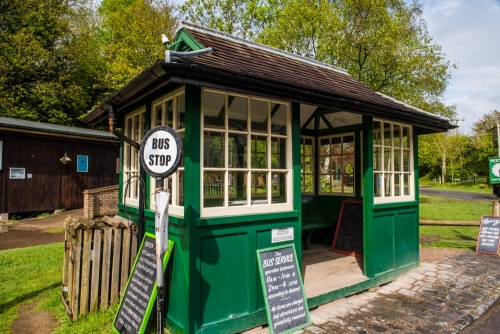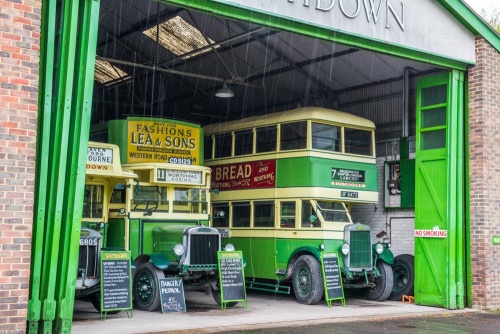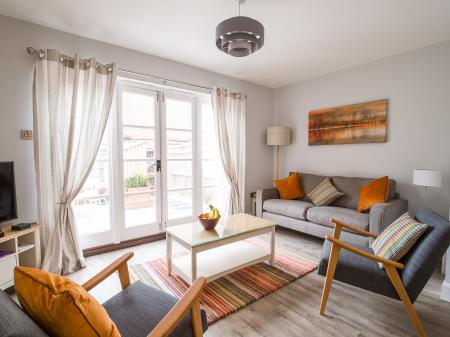
Among the highlights of the collection are the Southdown bus collection, wireless radio, a narrow-gauge railway, print workshop, ironmongers shop, brickhouse, wheelwright shop, machine shop, and much more.
There is an ongoing programme of special events and educational activities aimed at giving the younger generation an appreciation of traditional crafts and trades.
A narrow-gauge railway runs through the site, as does a historic bus service, allowing visitors to explore Amberley in a nostalgic style. The narrow-gauge railway was built from the original industrial railway stock used to carry limestone from the quarry to the kilns. One railway feature is a signal box from Billingshurst, dating to before 1876, which has been saved from destruction and reassembled on site.
Volunteers keep alive traditional rural crafts and you can watch skilled artisans creating pottery, turning wood, using vintage printing presses, and making stained glass. At least three crafts are demonstrated every day, but exactly which crafts you can see depends on the availability of the volunteer craftspeople.

When we visited there were volunteers in the museum's Printing Workshops, operating a variety of historic printing presses. The oldest piece of equipment was a Columbian ‘Eagle’ flat-bed press (c.1856). A volunteer showed us how the press operates and answered all our questions about the process of setting type and making prints using traditional printshop equipment.
The printing workshop is not a static museum-piece but an actual working printshop; you can buy postcards, wrapping paper and postcards printed in the workshop.
History
The museum is spread out over a once-busy chalk quarry and lime works, with over 40 buildings spread across the site. Some buildings were salvaged from destruction and reassembled here at Amberley.
Among the latter is the Fairmile Cafe, a wooden building erected in 1939 to serve motorists between Fontwell and Arundel. The cafe building was saved from demolition, disassembled, transported to Amberley, and now serves as a cafe once more on special days throughout the year.
Exhibits show how much life has changed since the advent of the Industrial Revolution, with a focus on the south-east of England. The collections include historic mine buildings from the days when the De Wit Kilns processed limestone quarried from the surrounding chalk cliffs. The best reminder of the museum's mining origins are the De Wit Kilns, built in 1905.
Exhibits
Fire Station
This 1950s style building shows historic fire engines, pumps, and exhibits on the history of fire-fighting.

Village Garage
A replica 1930s garage, with a petrol station and attached bicycle shop. The garage is full of period tools and repair equipment, bringing back the golden age of motoring.
Connected Earth
One of the most intriguing exhibits at Amberley tells the story of how people communicate; with displays spanning the history of telecommunications.
Electricity Hall
Almost a museum in itself, the Electricity Hall covers the discovery of electricity and the development of electrical domestic appliances. See early forms of light bulbs, electricity generators, electric vehicles, transformers, power cables, and much, much more. This truly is an outstanding exhibition and well worth spending time exploring, especially for families or school groups.

Southdown Bus Garage
This replica of a 1920s garage houses a collection of vintage buses, as well as a display on the history of Southdown itself.
Wireless Exhibition
From early radios to television, ham radio to morse code, this fascinating exhibit looks at domestic, military, amateur and professional communications equipment. Part of the Exhibition is an amateur radio station, which is in operation when volunteers are available. See how home radios and television equipment has changed over the years; it's a real trip down memory lane.
Railway Exhibition
See narrow gauge railway exhibits and watch the restoration of vintage locomotives.

One of the more unusual exhibits at Amberley showed a cross-section of road construction from different time periods. Side by side you could see Roman road construction next to a medieval road and a modern road. The Paviors Museum nearby looks at how roads developed over time and houses a collection of vintage and modern roadwork machinery.
You can also see how different kinds of bricks were traditionally made, including highly decorated examples and curved bricks made for ornate chimney stacks.
One of the most unusual structures at Amberley is a twelve-sided building that once housed a horse-powered gin. No, not the kind of gin that you drink, but a horse-powered engine, or 'gin'. The horse would be tethered to a central upright shaft, and as the horse walked around and around, the shaft turned a set of gears that, in turn, powered grindstones for crushing flax seeds. The 'gin' building comes from Arundel and dates to sometime before 1805.

Another small building was originally used as a fuel store for the quarry and limeburning works. It has been restored as a simple rural telephone exchange, of the type used in this area from the 1930s. The building houses telephone equipment from the Coolham exchange that was removed when that exchange was being modernised. Visitors can use demonstration telephones and see how a typical rural exchange worked, but the exchange is more than an exhibit; it actually powers the Museum's internal telephone system.
The Amberley Museum is unlike any other museum our family has visited. It is somewhat like popular open-air museums such as the Beamish Museum in County Durham or the Weald and Downland Museum, but it is unique in the sheer range of historic buildings, trades, and crafts covered. Plan on spending a long time at Amberley!
The museum is well signposted off the B2139 through Amberley village. It is located immediately beside Amberley Rail Station and there is a large free parking area for visitors.











